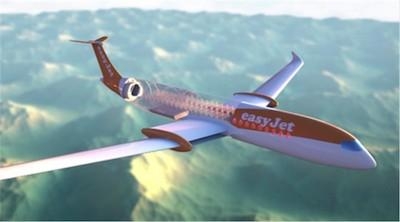Mens et Manus—and Then Some
Aviation’s carbon footprint is among the environmental debates hot-button issues. Alternately compelled by a vociferous activist contingent, the desire for favorable optics, and the promise of immense profits, a veritable legion of companies spanning a gamut bookended by embryonic startups and international conglomerates are presently about the business of dreaming up and testing ostensibly sustainable solutions by which humankind’s and the planet’s best interests may be contemporaneously served.

From allegedly renewable fuels such as Neste’s My Sustainable Aviation Fuel to new-fangled propulsion schemes the likes of Ampaire’s hybrid-electric and Universal Hydrogen’s hydrogen-electric powerplants to avant-garde aerodynamic stratagems like Natilus’s Blended Wing Body (BWB) architecture, the campaign for new aeronautical technologies is being fought on numerous fronts.
The latest aspirant to enter the fray is the Massachusetts Institute of Technology (MIT), the renowned private land-grant research university that, since its 1861 founding, has produced no fewer than one-hundred Nobel laureates, 26 Turing Award winners, and eight Fields Medalists.
On 08 June 2023, MIT’s campus news outlet reported a group of MIT engineers has set out to design and build a one-megawatt electric motor conducive to the propulsive needs of larger aircraft.
To date, the band of boffins has tested the inchoate motor’s major components and demonstrated by dint of detailed computations that the contraption, once completed, will output one megawatt of power at a weight and size consistent with those of extant small aero-engines.
Compatible with full-electric and hybrid-electric power-sources, the motor stands to impel both conventional and Advanced Air Mobility platforms. Final conversion of the motor’s kinetic-energy to thrust will be via propeller or rotor.
Zoltan Spakovszky, MIT professor of aeronautics and director of the school’s Gas Turbine Laboratory (GTL), stated: “No matter what we use as an energy carrier—batteries, hydrogen, ammonia, or sustainable aviation fuel—independent of all that, megawatt-class motors will be a key enabler for greening aviation.”
Spakovszky, who heads up the megawatt motor project, along with members of his team and industry collaborators, will present their work at a special session of the American Institute of Aeronautics and Astronautics set to convene at June 2023’s Electric Aircraft Technologies Symposium (EATS).
The MIT team consists of faculty, students, and research staff from GTL and the MIT Laboratory for Electromagnetic and Electronic Systems. The project is sponsored by Mitsubishi Heavy Industries (MHI).
Speaking to the subject of mitigating human-induced climate change, Spakovszky set forth: “There is no silver bullet to make this happen, and the devil is in the details. This is hard engineering, in terms of co-optimizing individual components and making them compatible with each other while maximizing overall performance. To do this means we have to push the boundaries in materials, manufacturing, thermal management, structures and rotor-dynamics, and power electronics.”
The megawatt electric motor and governing electronics under development by Spakovszky and his acolytes are (each) about the size of a suitcase and weigh less than two-hundred-pounds. The powerplant consists primarily of a high-speed rotor lined with magnets of varying orientations of polarity; a compact low-loss stator that fits within the rotor; an advanced heat exchanger; and a distributed power electronics system comprising thirty custom-built circuit boards configured to precisely modulate the currents running through the stator’s copper windings.
Spakovszky asserted: “I believe this is the first truly co-optimized integrated design. Which means we did a very extensive design space exploration where all considerations from thermal management to rotor-dynamics to power electronics and electrical machine architecture were assessed in an integrated way to find out what is the best possible combination to get the required specific power at one megawatt.”
For purpose of minimizing transmission loss and allowing the integrated heat exchanger to function efficiently, the MIT design calls for the motor’s distributed circuit boards to be close-coupled with its primary rotor and stator components.
“This is a high-speed machine, and to keep it rotating while creating torque, the magnetic fields have to be traveling very quickly, which we can do through our circuit boards switching at high frequency,” Spakovszky explained.

To mitigate risk, the MIT team built and tested the motor’s major components individually, thereby demonstrating such are capable of operating to and even beyond their respective design limitations.
Spakovszky’s team plans to assemble the first fully-functional megawatt motor in the autumn of 2023.
Phillip Ansell, director of the Center for Sustainable Aviation at the University of Illinois Urbana-Champaign, remarked: “The electrification of aircraft has been on a steady rise. This [MIT] group’s design uses a wonderful combination of conventional and cutting-edge methods for electric machine development, allowing it to offer both robustness and efficiency to meet the practical needs of aircraft of the future.”
“I think we’re on a good trajectory,” Spakovszky concluded. “We are not electrical engineers by training, but addressing the 2050 climate grand challenge is of utmost importance; working with electrical engineering faculty, staff, and students for this goal can draw on MIT’s breadth of technologies so the whole is greater than the sum of the parts. So we are reinventing ourselves in new areas, and MIT gives you the opportunity to do that.”
 ANN's Daily Aero-Term (04.28.24): Airport Marking Aids
ANN's Daily Aero-Term (04.28.24): Airport Marking Aids Aero-News: Quote of the Day (04.28.24)
Aero-News: Quote of the Day (04.28.24) ANN's Daily Aero-Linx (04.28.24)
ANN's Daily Aero-Linx (04.28.24) Aero-News: Quote of the Day (04.29.24)
Aero-News: Quote of the Day (04.29.24) ANN's Daily Aero-Linx (04.29.24)
ANN's Daily Aero-Linx (04.29.24)




